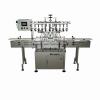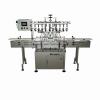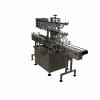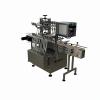GLOBALTEK® Fill-It In-Line Automatic Bottle Filling Machine with Pressure Overflow System
The GLOBALTEK® Automatic Overflow Fill-It is a specialized automatic bottle-filling machine designed to fill every container to the same level, regardless of the internal volume of each bottle. This bottle-filling machine uses a nozzle that overflows the liquid into a holding tank once the desired fill level is reached. The liquid filling machine utilizes advanced indexing and a PLC system, enabling continuous bottle filling without manual operation during each cycle.
Main Features:
- 304 Stainless steel and anodized aluminum heavy duty frame fully enclosed with stainless steel panels.
- 20 Gallon stainless steel covered overflow tank with level sensor and sanitary fittings.
- 304 stainless steel feeding 3A certified manifold with clear PVC hoses.
- Mounted on four heavy duty threaded leveling pads
- Variable speed control for conveyor
- Pump speed, acceleration, and deceleration is controlled by a frequency drive.
- Front panel start and emergency stop
- Automatic tool-less neck guides included as standard to prevent spillage
- Automatic tool-less bottle indexing gates to control container travel (entry and exit)
- Tool-less nozzle mount adjustment (0 to 4 inches)
- Made in USA
- Conveyor not included
Optional features:
- Automatic drip tray
- Electric bottle height adjustment
Technical Data
- Omron (up to 100 recipe filling cycle parameters for recall) PLC control with 7” touch screen HMI
- Expandable up to 16 nozzles to increase speed.
- No bottle / No fill sensor
- Batch bottle counter records number of filling cycles completed
- Sensor for downstream back pressure
- Includes centrifugal pump: 96 gallon per minute, 1 HP / 3 ph. 316 stainless steel construction
- Linear guide with linear bearings for ease when moving nozzle mount.
- Nozzles move up and down with pneumatic driven 4-inch stroke cylinder
- Hand wheel bottle height adjustment. (1 to 16 inches high)
- Air filter-regulator included.
Electric and pneumatic requirements:
220 Volts, 60Hz, 10 Amps. 5 CFM @ 80 p.s.i.
How an Automatic Bottle Filling Machine Works
Automatic overflow filling controls fill height rather than volume. Bottles are precisely indexed beneath the nozzles; product flows until it reaches the set level, then any excess returns to the recirculation tank. The result is a consistent visual level across bottles—even when internal volumes vary. This method is ideal for clear containers and free-flowing, non-particulate liquids where shelf appearance matters. Proper nozzle submergence and dialed-in ramp profiles minimize foam, while stored PLC/HMI recipes keep changeovers fast and repeatable.
Overflow vs. Volumetric Filling: Pros & Cons
Overflow (Level-Fill)
-
Pros: Identical visual fill height in transparent bottles; fast changeovers; recirculation reduces waste.
-
Cons: Controls level—not exact mL/oz—so it’s less suited to higher viscosity or particulate products.
Volumetric (Piston / Flow-Meter)
-
Pros: Delivers precise volume per container; better for viscous or particulate applications.
-
Cons: Fill height can vary with bottle tolerances; cleanouts and change parts may require additional time.
Quick guidance: Choose overflow when a uniform shelf appearance is the priority. Choose volumetric when labeled volume accuracy is the governing requirement.
Maintenance Checklist for Your Bottle Filling Machine
Daily
-
Flush the product path; confirm overflow/return is clear.
-
Inspect nozzles for residue; verify no-bottle/no-fill and downstream back-pressure sensors.
-
Check indexing gates and neck guides for alignment; test the emergency stop.
Weekly
-
Inspect hoses, clamps, and sanitary connections for wear/leaks.
-
Verify conveyor timing relative to nozzle up/down motion; review key HMI recipes.
Monthly
-
Lubricate linear guides and bearings per spec.
-
Inspect pneumatic components and drain air filters; confirm repeatable stroke.
-
Validate pump VFD acceleration/deceleration to control surge and foam.
Quarterly
-
Perform full CIP/SIP as applicable; replace worn gaskets and O-rings.
-
Audit guards and fasteners; back up current PLC/HMI parameters.
Frequently Asked Questions









